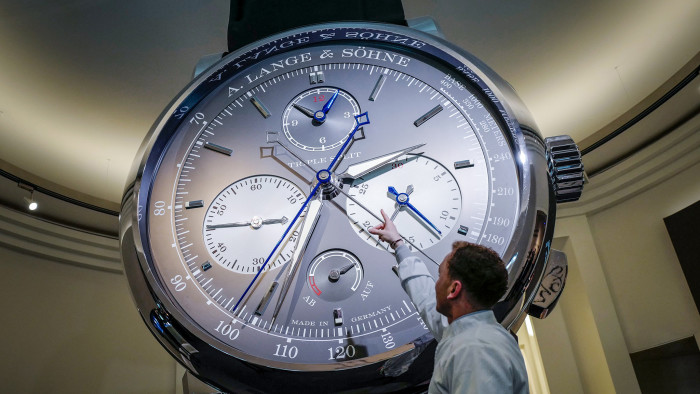Luxury watch leaders braced for risk and opportunity in 2019

Roula Khalaf, Editor of the FT, selects her favourite stories in this weekly newsletter.
The watch industry’s monolithic fairs are beginning to move away from their traditions at a time when various forces are affecting sales patterns globally.
Yet with exports of Swiss watches up about 7 per cent by value last year, watchmakers are entering 2019 with an air of optimism. Some of the industry’s leaders share their expectations for the year ahead.
Asia
Asian millennials will buy more diverse and casual watches to wear in ever more informal workplaces, predicts Panerai’s chief executive, Jean-Marc Pontroué.
New markets are also emerging. Take Indonesia, which according to Vartkess Knadjian, chief executive at London-based watchmaker Backes & Strauss, has “very wealthy entrepreneurs who shop in places like Singapore, and retail environments are being created in cities like Jakarta”. Bremont co-founder Giles English points to Sri Lanka as a growing retail market as “the Chinese are going there more and more”.
Currency fluctuations can pose a threat to sales of Swiss watches among Chinese tourists, who “only buy when they can make a bargain . . . as soon as the currency moves”, says Davide Cerrato, managing director of Montblanc’s watch division.
Grégory Dourde, chief executive at HYT, anticipates that stricter customs controls in China on goods bought overseas will lead to Chinese clients buying more watches at home.
Distribution and sales
Watch brands will invest more heavily in digital platforms such as Weibo, WeChat and others next year, Mr English expects, and less in stores — a strategy that Bremont itself will pursue in the second half of this year.
Bricks-and-mortar stores will remain the main distribution channel but watchmakers will continue to reduce numbers, agrees Guido Terreni, managing director of the watch division at LVMH-owned Bulgari.
Brands will seek to regain some control from the multibillion-dollar so-called grey market, where watches are sold by unauthorised dealers, often at a discount. Mr Dourde says watchmakers’ focus on boutiques dedicated to just one brand will give them more control over stock supply and provide other retailers with less scope to offload surplus volumes on to dealers at a reduced price.
Watchmakers will also seek a greater slice of the thriving second-hand market, asserts Bremont’s Mr English. He believes many will look to buy back their brand’s used watches from customers, or from dealers and online platforms such as Watchfinder. “Brands will start to sell their own second-hand watches in stores, especially the limited editions which have real value,” he adds.
Mr English also predicts resale sites could prove to be “gold dust” for a group or big brand looking to acquire a new, large customer database. “It’s happened with Richemont and the second-hand [digitally focused] Watchfinder, so why not?” he says.
Jon Cox, head of European consumer equities at Kepler Cheuvreux, a research firm, reckons the grey market could evolve to where consumers buy a watch to sell it on in its unopened box for a profit via these second-hand platforms.
Consolidation
With so few viable independent watch brands available, acquisitions will be thin on the ground, says Mr Terreni. Instead, expects Peter Harrison, chief executive of Emea at Richard Mille, big groups will look to offload their weaker brands and consolidate some areas of manufacturing. To safeguard exclusivity, manufacturers will be restricted in creating components for other brands, he adds.
As for watch fairs, 2019 in many ways heralds the death of a timeworn format and further change appears inevitable. Mr Knadjian says: “The way we are able to communicate today with information [has changed], you can send pictures and do live broadcasts.
“If shows have a future they have to be restructured and rethought.”
Comments